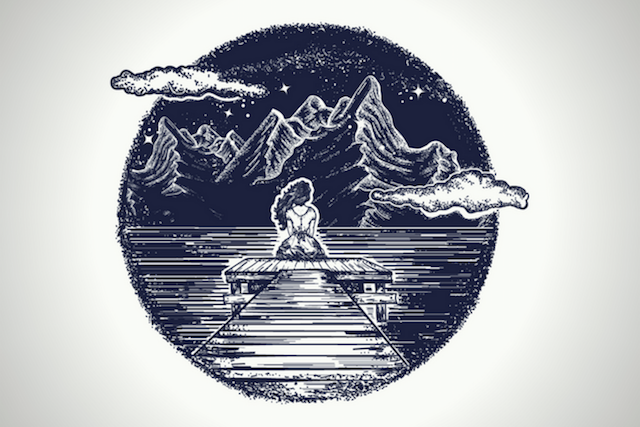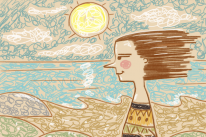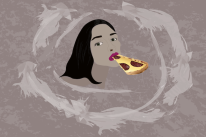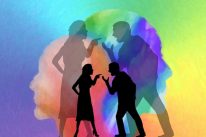
TRIGGER WARNING: This post deals with an account of sexual abuse and may be triggering to some people.
“Our wounds are often the openings into the best and most beautiful parts of ourselves.” ~David Richo
In my mid-thirties, I had what I experienced as a breakdown.
If you had asked me ten or even twenty years earlier whether I had been sexually abused, I would have said no. But in my mid-thirties, strange and scary memories started surfacing in my body—along with pieces of story and language.
These pieces of memory and my responses to them seemed to glue together many of the disconnected, unincorporated experiences of my life; it was as if I were connecting the dots and seeing a shape that had been there all along but that I had never perceived before.
In part, my reading had taken me to recognizing the trauma that I was unearthing. I found myself reading again and again about violence: violence in war, in families, in almost every facet of society. And almost every book I read about violence referenced Judith Herman’s Trauma and Recovery. So finally I took the book out from the library.
Reading the book, I felt as if I were looking in a mirror.
I thought I’d had an easy, carefree childhood. Now I needed to reconfront that story and reimagine who I was.
Herman’s book, published more than twenty-five years ago, is still the bible of trauma studies: it maps out, step by step, how trauma and PTSD affect people; it draws the link between public and private traumas, between PTSD in war veterans and survivors of domestic and sexual abuse.
It put into language so many of the experiences that I had never been able to name: feelings of dissociation, disconnection between the mind and the body, fear, self-blame.
At first the experience of reading the book was empowering, and then, as the memories became stronger, I began to have panic attacks. I felt as if I were in the grips of something so much more powerful than myself that I didn’t know if I’d make it through.
It was as if enormous waves of pain and horror were sweeping over me, and I would lose all sense of myself, all grounding. I felt somersaulted, upside down. I felt as if I was losing the person I had been, slipping away from my old, composed, presentable self into a new identity dominated by this early wounding, scared by the world around me, horrified at what humans do to one another, unable to even imagine feeling safe.
I felt as if the ground were falling out beneath me.
Over time, I came to piece together the trauma story: a babysitter had sexually assaulted me when I was very young. Because I was so young and because there were no other witnesses, fear, horror, and shame were lodged in my body without having clear language around them.
But at first, as the memories started to come, my memories were more physical than verbal: I experienced physical sensations and flashbacks of being pinned down, of not being able to breathe, and piercing sensations of both physical pain and psychological and existential terror.
It took all of my energy to keep my life from falling apart. I was a mom of two young kids and had a relatively successful professional life as a writer and academic. But now I didn’t have any energy for anything other than raising my kids and taking care of myself.
I tried to concentrate my energy on bringing my best self forward to get through the day for my kids and to keep up with the daily demands and to be the kind of mom I wanted to be—present, listening, compassionate, even fun. I was able (mostly) to remember how to do this in their company, and the routine of being with them kept me on track and reminded me of the good in the world and, despite my pain, of hope and love.
But once they went to sleep at night, I was immersed in a dark world of struggle.
I didn’t know who I was anymore. And my basic trust in my body and in the world felt eroded. Along with the physical memories of the sexual assault and my fear and horror was a deep physical sensation of shame.
For complex reasons, shame seems to arise as one of the symptoms of sexual abuse, more than in other forms of trauma, especially when the abuse occurs in children. The violation of the body often brings up feelings of self-blame, of separation from the self, and of disgust that gets turned on the self.
In children especially, it is often easier to blame themselves than to blame the adults who should be taking care of them—it’s a way, subconsciously, to create an image of a safer world, where the adults are reliable, and a sense of control.
So when these feelings came flooding back with the memories of what had happened, even though intellectually I understood I had not in any way been to blame, I was nevertheless overcome by a physical sensation of shame, spreading from my stomach up into the rest of my body.
Because the wounding had affected me so deeply, I (irrationally) felt that it had colored every part of me, as if I were covered in filth. I felt as if the very fact that I had been violated as a child spread contamination in my own house as an adult.
When I wrote, the stories I found myself telling were stories of trauma and horror, violence and violation. And I wasn’t comfortable sharing these stories. These weren’t the stories I wanted to be putting into the world. I largely put my writing career on hold, unsure of whether I’d ever get back to it.
It was 2009. Sexual abuse was still largely a taboo topic. I felt that I would be judged poorly if I shared my experience.
I didn’t personally know anyone who was public about childhood sexual abuse. Or if I did, it was something long in the past that seemed no longer to affect them. I certainly didn’t know anyone who was public about being affected by PTSD. And it was clear that what I was suffering from was PTSD.
I didn’t know anyone who had healed from PTSD. Was this a life sentence?
At first, I had thought I would get through this breakdown relatively quickly, but I found myself plunging farther and farther.
Ashamed and scared that I would never heal, my crisis was something I mostly kept to myself. For a long time, I didn’t tell anyone what I was going through other than my husband, my very best friends, and the professionals I reached out to for support.
I had friends who got sick with other illnesses, and mutual friends looked after their kids, brought home-cooked meals, and the whole community came out in support. But I had no such support, and so in its own way the secrecy around my struggle with PTSD perpetuated the cycle of shame and the silence that I had experienced as a young child.
One year turned into two and then three. The future that I imagined for myself as a writer and professional seemed forever out of reach.
Gradually, though, and very slowly, I worked my way out of the crisis. I began to put myself back together, but with a less rigid story of myself.
I went to therapy. I joined groups of women also suffering from PTSD and practiced speaking about what was happening to me. I developed a strong meditation and yoga practice.
I began to break the silence and reformulate my own story, and I wrote and wrote in my journal at night, a safe place where no one could see what I was struggling with, but where I could learn to witness all the many different parts of myself.
Putting into language what had happened and listening to my body with compassion helped me begin to turn the tide.
As I began to tell just the few people I felt most safe with, many people who I never knew had suffered from trauma began to tell their trauma and healing stories to me, or friends would put me in touch with other friends who had also suffered from sexual abuse and healed. There was a whole underground network of people sharing stories and sharing techniques about how they had healed.
I was so moved by the stories I was hearing haphazardly that I began to interview people who had suffered any number of different kinds of trauma to understand how they had gotten through their crises. I wanted to learn more for myself if and how people got through the healing crisis and came out on the other side.
I talked to people who had lost their children and people who had been incarcerated, people who had suffered serious cancers and people who had healed from sexual abuse. I learned from their strength and their ability to make sense of and learn and grow from their own stories—a capacity that I saw made many draw on a deep spiritual sense of self and connection.
In the people I interviewed, I saw not people broken by trauma, but strong people with great vivacity and much to teach. And I saw that the people who could tell compelling narratives about their life experiences, that is, those people who had really faced head-on, explored, and healed, had a kind of luminosity to them.
Many had suffered a great deal, but in the face of that suffering, many of them had also found an internal and spiritual richness to meet their challenges.
Listening to others, I came to have more distance from my own suffering and came to be able to witness my story from the more compassionate space of a witness.
As I saw how others had grown and deepened in response to their life experiences, I also began to reframe what I was experiencing. I came to develop my own spiritual life more fully. I deepened my meditation practice and was trained as a kundalini yoga teacher.
Though I had been eager to get on with my life and had perceived the pain and turmoil I was in as harmful and keeping me from all that I wasn’t doing (getting on with my career, etc.), over time, I came to see that that period was not a breakdown, but a time of healing, transformation, and growth.
And I came to see that I was only able to go through that period of healing and transformation because I was strong enough to bear to look at and process what I had not been able to bear as a child or even as a younger woman. I needed a certain amount of stability in my life and inner strength to face the challenges of my past and allow myself to remember my horror and confusion.
And as I did this, I began to develop new strength and appreciation within myself.
What can feel like weakness, confusion, and failure very often is the doorway to courage and resilience.
Today, I am happy to say that not only have I healed my PTSD, but I also feel much better physically and emotionally than I did before my crisis. I’m able to listen with more openness, compassion, and understanding not only to myself but also to the suffering of others’ around me. And I’m more able to let go of my fear of joy, what Brené Brown calls foreboding joy, and be fully present for the pleasures and beauty of the world.
I was able to heal because others shared stories that let me know that healing was possible. These stories gave me faith in the ability to heal and were the foundation for allowing me to do the work necessary to get through the crisis. They allowed me to see the disruption in my life and psyche not only as a descent into darkness but also as a path to more light.
Because I knew to trust the process, even when a part of me found it hard to believe there was ever going to be a light at the end of the tunnel, I kept going.
From Judith Herman’s Trauma and Recovery to the friends who shared their stories to the therapists who offered trauma support groups to the yoga and meditation teachers who offered their wisdom, I was supported by others who knew about and believed in the possibility of healing from PTSD.
There were any number of times when I might have turned away from healing in despair, when I might have looked outside myself to solve my problems, turning to substances or throwing myself back into work or even looking to move or change my marriage, instead of staying with the pain inside of myself.
But I was supported because I knew that the pain and even the shame were part of the process—that they were not unique to me, that there was no way around, but only through, and that when I felt I had hit a wall, it was not time to stop, but instead time to look for extra support and more tools.
If we believe a narrative that tells us that we need to be moving forward all the time and that feeling pain and shame is a sign of weakness, we will almost certainly miss out on opportunities to heal and grow.
Like Brené Brown, who calls her breakdown a spiritual awakening, I believe that we can only grow if we allow ourselves to go to those difficult, hurting places, if we don’t expect our lives to unfold in a straight line, and if we share stories not only of the way trauma happens but also of the ways healing happens.
We need to talk about how healing takes time and energy; the way it often seems to take us down before it can bring us up; the way we sometimes need to go back before we can go forward; and the way, ultimately, it can make us much happier, healthier, more connected to ourselves and others, and more resilient, if we stay with it.
And we need to make safe places available for healing so that it can run its course. We need to give people time and safety and understanding.
In the past, cancer was a word that was only whispered, as if the disease itself were somehow secret and shameful. Today, we are public about cancer, but we still often whisper about abuse and PTSD.
The #metoo movement is starting to change this; more and more people are coming forward to publicly share their stories of abuse.
And just as our trauma stories are powerful, our healing stories are equally powerful and important. We can and must break the silence and taboo not only around the trauma itself but also around the complicated, messy, long, but ultimately rewarding process of healing from trauma.
Though PTSD is not often spoken of, it is estimated that 10% of women will develop PTSD in their lifetime and that at any time more than 5 million people in the US are suffering from PTSD. But it’s likely that those numbers are much too low.
We live in a largely traumatized world, and we can’t heal that trauma if we don’t have the tools to recognize it, name it, witness it, and patiently offer supports for the healing process.
Denial and shame are natural but immature coping mechanisms and ultimately prevent healing. It can be difficult to break these patterns and look directly at the truth; facing what is difficult can lead to what seems like a crisis and breakdown, but if we stay with our experiences, trusting in the power of healing, we can transform, both as individuals and as a society.
About Nadia Colburn
Nadia is the founder of Align Your Story Writing School and Coaching, which helps women unlock their full creative voice. She's the author of the poetry book The High Shelf and her work has been widely published in The New Yorker, American Poetry Review, Kenyon Review, etc. For free recorded meditation and writing sessions, writing prompts, yoga and writing videos, and other free resources for writers, visit nadiacolburn.com.













 Though I run this site, it is not mine. It's ours. It's not about me. It's about us. Your stories and your wisdom are just as meaningful as mine.
Though I run this site, it is not mine. It's ours. It's not about me. It's about us. Your stories and your wisdom are just as meaningful as mine. 